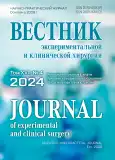Effectiveness of Enzymatic Necrolysis in Patients with Burns
- Authors: Alekseyev A.A.1,2,3, Bobrovnikov A.E.1,2, Malyutina N.B.1,2,3, Bogdanov V.V.2, Chilikin N.M.2, Markarov A.E.3
-
Affiliations:
- Russian Medical Academy of Continuous Professional Education
- A.V. Vishnevsky National Medical Research Center of Surgery
- City Clinical Hospital named after F.I. Inozemtsev of the Moscow Health Department
- Issue: Vol 17, No 4 (2024)
- Pages: 183-191
- Section: Experience
- URL: https://journal-vniispk.ru/2070-478X/article/view/273801
- DOI: https://doi.org/10.18499/2070-478X-2024-17-4-183-191
- ID: 273801
Cite item
Full Text
Abstract
Rationale. Currently, there has been developed a technique for managing enzymatic necrolysis of II-III degree burn wounds using the two-component drug NexoBrid; this treatment option is possible to apply only in the early terms, up to 72 hours, after injury. There are no indications for the use of the technology in later terms after the injury.
The aim of research was to study the potential and effectiveness of enzymatic necrolysis when using the drug NexoBrid in patients with burns of II-III degree at various stages after injury (before and after 72 hours).
Methods. The study included 23 patients. In 15 cases, enzymatic necrolysis with Nexobrid was carried out in first 72 hours after injury; in 8 cases, in 5-9 days after injury.
Results. In both groups, comparable results were obtained regarding the effectiveness of enzymatic necrolysis. The use of enzymatic necrolysis at the late stages (7 days) after injury was effective in the presence of moist necrotic tissue in the wounds, which allowed simultaneously, in the shortest possible time, cleaning burn wounds with uncomplete dermal necrosis (borderline burns of II degree and “mosaic” burns II-III degree) from necrosis, transforming wound process to second stage, creating conditions for regeneration of borderline and “mosaic” burns from the remaining skin derivatives with underlying use of dressings, thus creating a moist wound environment, and in the case of deep burns, reducing the time of their preparation and the area of autodermoplasty.
Conclusion. The use of enzymatic necrolysis with the drug NexoBrid in patients with burns of II-III degree is effective up to 7 days after injury in the presence of a moist scab in the wounds.
Full Text
##article.viewOnOriginalSite##About the authors
Andrey A. Alekseyev
Russian Medical Academy of Continuous Professional Education; A.V. Vishnevsky National Medical Research Center of Surgery; City Clinical Hospital named after F.I. Inozemtsev of the Moscow Health Department
Author for correspondence.
Email: alexseev@ixv.ru
ORCID iD: 0000-0001-6675-4794
SPIN-code: 4803-3939
Scopus Author ID: 720289106
M.D., Professor, Deputy Director, Head of the Burn, Head of the Department of Thermal Lesions, Wounds and Wound Infection
Russian Federation, Moscow; Moscow; MoscowAlexander E. Bobrovnikov
Russian Medical Academy of Continuous Professional Education; A.V. Vishnevsky National Medical Research Center of Surgery
Email: doctorbobr@mail.ru
ORCID iD: 0000-0003-0926-6115
SPIN-code: 4203-1718
Scopus Author ID: 6602689492
M.D., Associate Professor, Head of the Burn Department, Professor of the Department of Thermal Lesions, Wounds and Wound Infection
Russian Federation, Moscow; MoscowNatalia B. Malyutina
Russian Medical Academy of Continuous Professional Education; A.V. Vishnevsky National Medical Research Center of Surgery; City Clinical Hospital named after F.I. Inozemtsev of the Moscow Health Department
Email: malutinanb@yandex.ru
ORCID iD: 0000-0001-8013-1913
SPIN-code: 6092-7986
Ph.D., specialist of the Organizational and Methodological Department, Associate Professor of the Department of Thermal Lesions
Russian Federation, Moscow; Moscow; MoscowVitaly V. Bogdanov
A.V. Vishnevsky National Medical Research Center of Surgery
Email: vbogdanov@inbox.ru
ORCID iD: 0000-0001-8499-9373
surgeon of the burn department
Russian Federation, MoscowNikolai M. Chilikin
A.V. Vishnevsky National Medical Research Center of Surgery
Email: zero-nbk@yandex.ru
ORCID iD: 0000-0003-0096-5681
SPIN-code: 7868-4353
surgeon of the burn Department
Russian Federation, MoscowArnold E. Markarov
City Clinical Hospital named after F.I. Inozemtsev of the Moscow Health Department
Email: gkb36@zdrav.mos.ru
ORCID iD: 0000-0002-0392-8280
SPIN-code: 8919-9645
surgeon of the burn Department
Russian Federation, MoscowReferences
- Ozhogi termicheskie i himicheskie. Ozhogi solnechnye. Ozhogi dyhatel'nyh putej. (klinichsekie rekomendacii). M. Obshcherossijskaya obshchestvennaya organizaciya «Ob"edinenie kombustiologov «Mir bez ozhogov». 2021; 179. (in Russ.)
- Koller J, Bukovcan P, Orság M, Kvalténi R, Gräffinger I. Enzymatic necrolysis of acute deep burns-report of preliminary results with 22 patients. Acta Chir Plast. 2008; 50: 4: 109-114.
- Singer AJ, Taira BR, Anderson R, McClain SA, Rosenberg L. The effects of rapid enzymatic debridement of deep partial-thickness burns with Debrase on wound reepithelialization in swine. J Burn Care Res. 2010; 31: 5: 795-802. doi: 10.1097/BCR.0b013e3181eed48e
- Rosenberg L, Krieger Y, Silberstein E, Arnon O, Sinelnikov IA, Bogdanov-Berezovsky A, Singer AJ. Selectivity of a bromelain based enzymatic debridement agent: a porcine study. Burns. 2012; 38: 7: 1035-1040. doi: 10.1016/j.burns.2012.02.011
- Rosenberg L, Krieger Y, Bogdanov-Berezovski A, Silberstein E, Shoham Y, Singer AJ. A novel rapid and selective enzymatic debridement agent for burn wound management: a multi-center RCT. Burns. 2014;40(3):466-74. doi: 10.1016/j.burns.2013.08.013.
- Rosenberg L, Shoham Y, Krieger Y. Minimally invasive burn care: a review of seven clinical studies of rapid and selective debridement using a bromelain-based debriding enzyme (Nexobrid). Ann Burns Fire Disasters. 2015; 28: 4: 264-274.
- Alekseev A.A., Zinoviev E.V., Kostyakov D.V., Manukovskii V.A., Filimonov K.A., Astrelina T.A., Kobzeva I.V., Hromina S.S., Derii E.K. Effectiveness of Autodermoplasty in Combination with Injection of Autological Stromal-Vascular Cell Fraction in Treatment of Deep Burns // Journal of Experimental and Clinical Surgery. - 2024. - Vol. 17. - N. 2. - P. 51-59. doi: 10.18499/2070-478X-2024-17-2-51-59.
- Alekseev AA, Malyutina NB, Tyurnikov YuI, Mitichkin AE, Bobrovnikov AE. An innovative technology for the treatment of patients with II-III degree burns based on the use of enzymatic necrectomy. Lechenie i profilaktika. 2021; 11: 2: 20-29. (in Russ.)
- Alekseev АА, Malyutina NB, Bobrovnikov AE, Shoham Y. Enzymatic Debridement of Deep Thermal Burns in the Russian Federation: First Experience. Life. 2023; 13: 488. https://doi.org/10.3390/life13020488
- Hirche C, Almeland SK, Dheansa B, Fuchs Р, Governa M. Eschar removal by bromelain based enzymatic debridement (Nexobrid) in burns: European consensus guidelines update. J Burns. 2020; 46: 4: 782-796, doi: 10.1016/j.burns.2020.03.002.
Supplementary files









